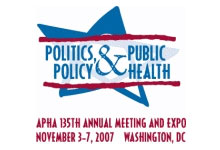In this Section |

159807 State refusal of federal funding for abstinence-only educationWednesday, November 7, 2007
Background: The federal government has been funding abstinence-only education through Section 510 of Title V of the Social Security Act since 1996. Four states have refused federal funding as of December 2006. This study explored the political, social, and economic forces which influence a state's decision to accept or reject Title V funding. Methods: Data was collected as structured case studies. Snowball sampling of state key informants identified archival materials such as evaluations, governmental communications, and public surveys. Results: States that rejected Title V monies raised a variety of concerns about the 510 programs including medical inaccuracies in abstinence-only curricula and the exclusion of non-heterosexual youth. Refusal states often had progressive governors and strong community-based organizations supporting comprehensive sexual education. Refusal states often cited evaluations that found little behavioral impact and polling data in support of comprehensive sexual education. Five comparison states accepting Title V money used the funding in resource poor regions, based sex education policies on the decisions of local committees or school boards, or had state education standards that emphasize abstinence-only or abstinence-plus curricula. Conclusions: State abstinence-only policies are directly influenced by the political, social, and economic environment in each state. In order to facilitate policy change in abstinence-only curricula, public health professionals must focus on building coalitions of comprehensive sex education supporters, challenging the medical accuracy of abstinence only curricula, building support for the human rights of non-heterosexual youth, and increasing funding for comprehensive sexual education.
Learning Objectives: Keywords: Adolescent Health, Education
Presenting author's disclosure statement:
Any relevant financial relationships? No I agree to comply with the American Public Health Association Conflict of Interest and Commercial Support Guidelines, and to disclose to the participants any off-label or experimental uses of a commercial product or service discussed in my presentation.
See more of: Perspectives in Reproductive Health: Youth, Women, HIV/AIDS/STI
See more of: APHA-Student Assembly |
